- This topic has 13 replies, 5 voices, and was last updated 6 years, 4 months ago by
 Bill Ward.
Bill Ward.
-
AuthorPosts
-
13 August 2019 at 2:00 pm #574378
 Bill WardParticipant
Bill WardParticipantHi,
After weeks of almost continuous cloud cover and some near biblical rain the sky cleared (well almost) right on cue for the Perseid peak! :-))
Captured 263 meteors on my various cameras and this…
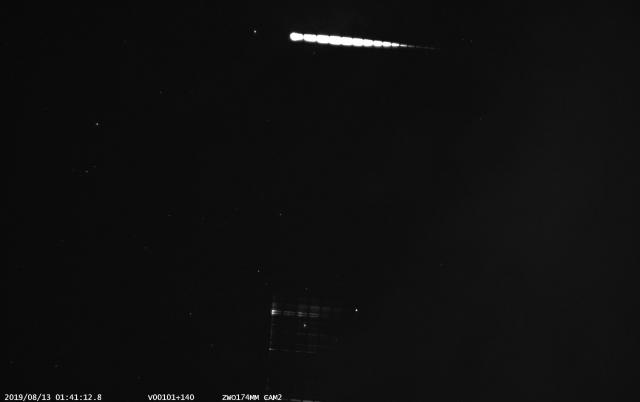
Maybe around -4, but it’s the spectrum at the bottom of the field that is truly exceptional!
Here’s a crop..
.
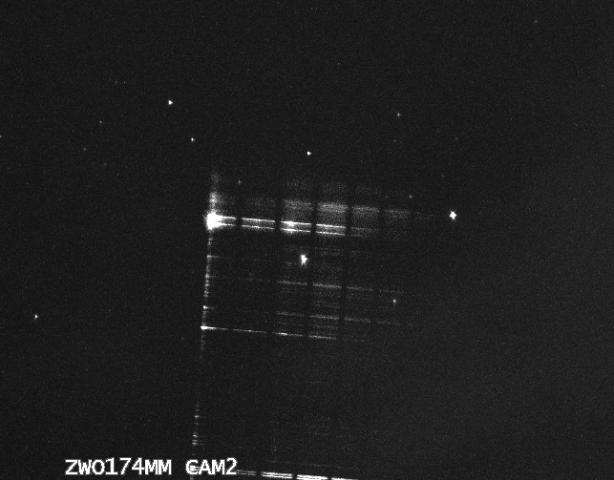
Unfortunately it’s only a partial spectrum but it is by far the highest resolution I have ever captured! The two brightest lines towards the top are the ionised calcium lines in the near UV. The tiny terminal flare exhibits MANY emissions!
Cheers,
Bill.
13 August 2019 at 3:39 pm #581253 Alex PrattParticipant
Alex PrattParticipantNice one, Bill !
My cameras were clouded out last night after midnight so unfortunately I can’t contribute any data for this one. The perils of our long baseline. Looking forward to seeing your detailed spectrum after processing.
Weather prospects here look better for tonight.
Cheers,
Alex.
13 August 2019 at 4:24 pm #581254 Bill WardParticipant
Bill WardParticipantYour wish is my command… 😉
First is across the third “chop” back from the terminal flare.
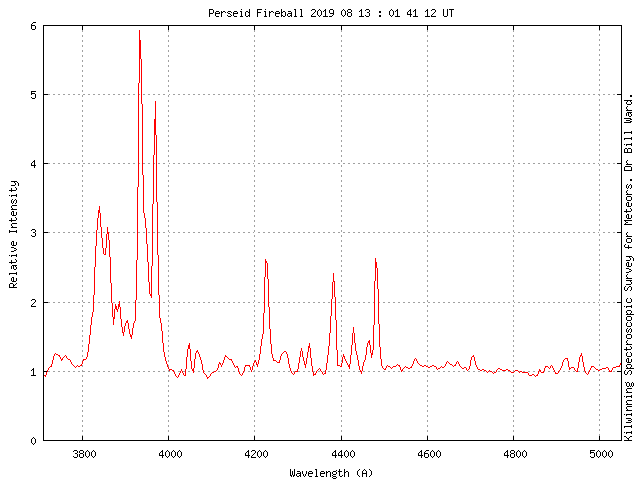
Second is across the terminal flare. Ca+ saturated but lot’s of metal lines light up. At least 35 lines (maybe a couple more) including the usual Mg, Ca and Fe but also Cr and Mn as well as possibly Ni.
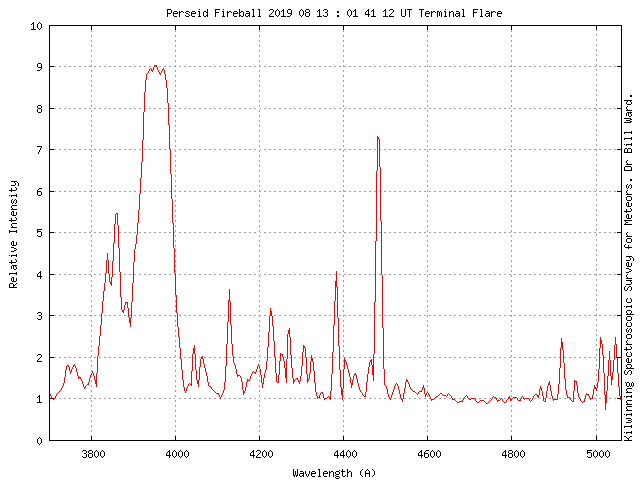
Despite it’s low efficiency, due to it’s embossed profile, I’m really surprised (and pleased) with the performance of the plastic film. I’m becoming convinced that it does have slightly better properties in the UV/Blue compared to the expensive glass gratings.The results are evidence enough I think…
R is around 1000, not bad for such a basic transmission set up.
Going to leave a couple of glass ones on but change the rest to plastic and see how it goes over the next season.
The weather gods certainly gave me a break last night but I think we’re in for more heavy showers tonight….
Cheers,
Bill.
13 August 2019 at 7:29 pm #581256 Alex PrattParticipant
Alex PrattParticipantYou’re resolving some fine details there Bill.
Fingers crossed for some mutual events tonight – but this weather system is spoiling the show.
Cheers,
Alex.
14 August 2019 at 2:32 pm #581262 Derek RobsonParticipant
Derek RobsonParticipantExcellent capture. Digitised spectrum looks really good.
16 August 2019 at 6:05 pm #581272 Mr Jack MartinParticipant
Mr Jack MartinParticipantBill,
Excellent spectra some good science there, well done.
Jack
Essex
19 August 2019 at 6:51 am #581286 Steve BosleyParticipant
Steve BosleyParticipantExcellent results Bill.
I’ve been thinking for some time that we should try again to get some spectra to supplement our videos here at Clanfield. I tried a few years back but gave up for various reasons. Do you have any documentation of your latest capture setup that would help a beginner get started ? What is the plastic grating you are raving about ?
Cheers
Steve
19 August 2019 at 10:27 am #581287 Bill WardParticipant
Bill WardParticipantHi,
The set up has always been, more or less…, the same. Stick a grating in front of your lens and see how it goes!
The plastic grating film now seems to be sold all over the place. The stuff I currently use I bought from Edmond Optics in 2009, £6.99 plus shipping etc. This was the second batch. The first was from the early 90’s. Trying searching for “holographic plastic grating film” or similar combination. Again, the stuff I bought, of US origin was sold in 12 inch x 6 inch sheets with either 12500 or 25000 lines per inch. I use the 12500 version which is just under 500 lines/mm.
It’s on Amazon and ebay as effect filter, novelty pattern filter, rainbow generator etc etc. You can even buy a 200 foot roll if you want to!
I should caution that TWO results (this and one other spoardic of almost the same magnitude) might not represent a statistically significant sample but with a bright enough meteor the plastic film seems to have a better throughput at the blue end of the spectrum than my much more costly glass gratings. Given the spec of the glass gratings this seriously surprises me! So I have now come to the conclusion that it’s a much more cost effective way to start should anyone wish to give meteor spectroscopy a go. I think this is pretty much old hat now as lots of stuff is online about it. I gave up on it when I ultimately stopped trying film based photographic spectroscopy which yielded precisely zero over 15 years prior to me using video. I decided to try it out again for financial reasons.
Due to the embossing process the grating is not blazed so equal amounts of light go into the spectrum on each side and because it’s a simple sinusoidal embossing the spectral throughput, overall, is less than a good glass replica. The upshot is you need brighter meteors to produce a spectrum all else being equal. Effectively you get half the light in your spectrum but at 1/20 the cost of a proper grating. It’s up to the prospective observer to decide whether that’s a reasonable cost/benefit analysis.
I used to have quite a bit of the stuff as I bought several sheets at the time but I have given it all away in little bits and pieces to those who wanted some to experiment with. At seven quid, cheaper from ebay, I don’t know if it’s exactly the same stuff though, it’s not going to break the bank.
Bit of a ramble but I hope it helps….
Bill.
20 August 2019 at 3:08 pm #581274 Bill WardParticipant
Bill WardParticipantah ha, I knew I had a picture of the triplet some where….
The power of spectroscopy, the same elements but on the sun (in absorption, not in emission as in a meteor spectrum!) I took this with a home made solar spectroscope, donkey’s years ago, it shows the main Mg lines plus a ton of Fe, Cr and Ti lines. These’ll be hiding in the meteor spectrum too!
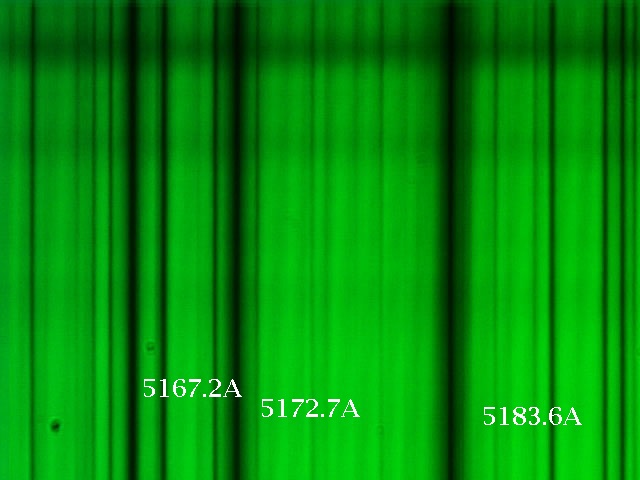
Cheers,
Bill.
20 August 2019 at 3:15 pm #581273 Bill WardParticipant
Bill WardParticipantHi,
Thanks Jack.
It gets better….!
Whilst concentrating on the flare as it had so many lines I didn’t really pay attention to the bright pair that ran close to the bottom of the image and through the camera ID text.
Taking a closer look revealed something remarkable. Since I started regular meteor spectroscopy around 2007 I’ve had the rather arbitrary goal of getting to a system that would resolve the bright green Mg triplet ~517nm. It’s tough to do completely!
When I chopped up the image and fitted the lines, it turns out that the “pair” is actually a partial resolution of the triplet! The 516.73nm and 517.27nm are just too close for this lens/grating/seeing combo but at the 1nm FWHM and 0.46nm/pix level it is just enough to see the 518.36nm line as separate, just over 1nm (2 pixels) between them. Here’s a plot with the brighter lines identified.
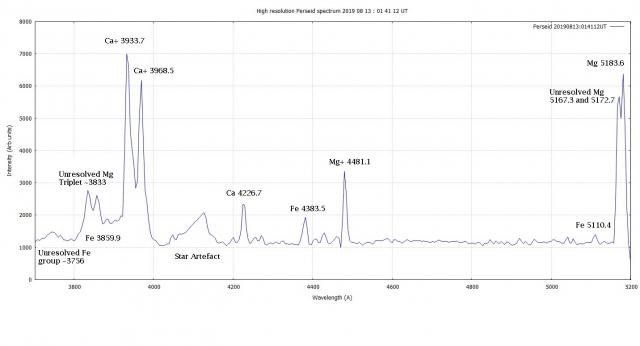
Well pleased with that!
Cheers,
Bill.
20 August 2019 at 3:16 pm #581265 Bill WardParticipant
Bill WardParticipantHi,
Done some more work on the spectrum and the lines in the trail are coming out with a FWHM of around 1nm and the measured dispersion is 0.46nm/pix. It’s now just about where I want to be. It’s seeing how all the little lines behave that tells the story…
Cheers,
Bill.
22 August 2019 at 5:13 pm #581299 Steve BosleyParticipant
Steve BosleyParticipantThanks Bill … I need to give this a go with my spare camera
Cheers
Steve
22 August 2019 at 8:01 pm #581301 Mr Jack MartinParticipant
Mr Jack MartinParticipantBill,
‘The power of spectroscopy’ your right about that, 85% of what we know about the Universe comes through dispersing the light of an object through a spectroscope !
So, keep up the good work.
Regards,
Jack
Essex
28 August 2019 at 3:24 pm #581317 Bill WardParticipant
Bill WardParticipantHi,
With running out of the stuff myself I had a look around the net at the various suppliers. Not that it makes much practical difference but it appears the film grating is sold as 1000 lines/mm (25400 lines/inch) or 500 lines/mm (12700 lines/inch).
I also found a supplier of 532 lines/mm crossed grating material which is an interesting product. In theory that should produce a useable spectrum no matter what angle the meteor fall across the FOV. However there is a BIG penalty in magnitude as the light per spectrum would now be divided into 8 spectra, four at right angles to each other and 4 fainter at 45 degrees. It’s probably more of a novelty laser pointer effect filter but….
I can feel some olde fashioned optical experiments coming along….
cheers,
Bill.
-
AuthorPosts
- You must be logged in to reply to this topic.
